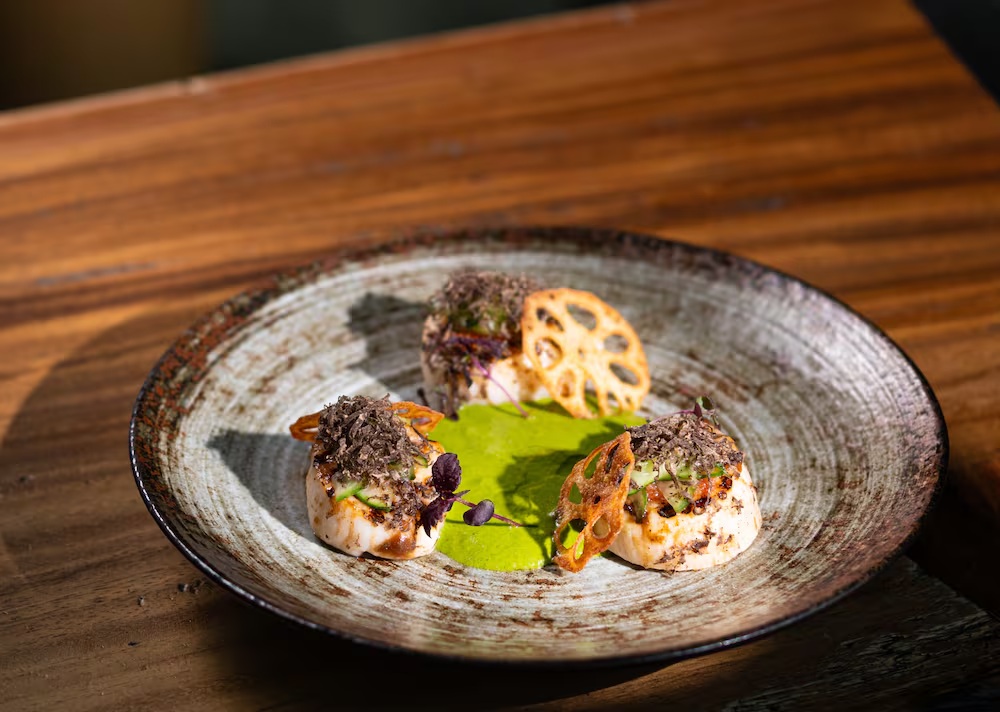Monitoring Desk
The term “pantry staple” is so boring. How are you expected to find inspiration from a dusty cupboard of jars, spices and unidentifiable flours?
Really though, the pickles and condiments hiding away in dark recesses have so much untapped potential. That sticky jar of honey needn’t only be used for tea or toast, nor should that curry paste be exiled to a life of Tuesday night curries. I can hear the mango chutney crying for attention from your refrigerator door.
They all deserve more than that one recipe you bought them for. These little guys are really flavour bombs that you can use to amplify your weeknight dishes. Imagine! Umami-rich, toasty, nutty and smoky treats to elevate and inspire your cooking, and they’re already sitting in your pantry.
First, let’s define what I mean by pantry. I’m a chef, an avid home cook, and of Asian heritage, so my pantry is stocked accordingly. What’s unfamiliar to some people is essential to others, so head to a supermarket or grocer and pick up an ingredient you ordinarily wouldn’t know what to do with. That’s what I’m here for.
That being said, let’s start with something most of us will probably have sitting in the fridge or pantry: ketchup.
Ketchup is underrated. We call it tomato sauce in Australia. Or just “sauce”. I like it, it’s straight and to the point. Like there are no other sauces.
Its uses are very clearly dictated in Australian culture: hot chips, sausage rolls and squeezed unceremoniously over a singed sausage on a slice of Tip Top white bread. You can find it in squeezy packets for an extra 50c with your meat pie, or in a dripping 4L jug next to the sporks at the chip shop.

According to Heinz, the key difference between ketchup and tomato sauce lies in the quantity of tomatoes used. Ketchup supposedly contains more tomato, in some instances it also contains tomato paste, so it is thicker and richer than its tomato sauce counterpart. But my taste tests suggests the true difference is between brands and price points, rather than between the terms “ketchup” and “tomato sauce”.
I bought all of the tomato sauces and ketchups available in my local supermarket, and tried them all for four key factors: sweetness, viscosity, acidity and complexity. We generally have Heinz at home, and I was surprised to find that it didn’t even make my top three. Here’s what I tried:
Rosella
Straight up, Rosella tomato sauce was like swallowing a mouthful of vinegar (I did actually eat a whole tablespoon of it and I don’t recommend anyone doing that.) The sauce is quite thin and watery, and there definitely isn’t enough sweetness to balance that hardcore acidity. The tomato flavour isn’t very pronounced either.
Beerenberg
Beerenberg was interesting, the sauce is quite thick, almost chunky, and there is a lot going on flavour-wise. Think lots of warm spices and a relentless onion flavour that basically overpowers the tomato. It’s definitely tasty, but more like a chutney than a tomato sauce.
Heinz
Very smooth and balanced sweetness and acidity. This is the only ketchup on the list, and lists “167g of concentrated tomatoes per 100mL.” No one else specified how much tomato is in their sauce, so I don’t really have a comparison point. It could be heaps and it could be average. Anyway, the spices are quite pronounced in a pleasant way and the sauce has a lovely silky texture. An all-rounder.
Fountain
Another good all-rounder. Fountain tomato sauce has quite a lovely, rich tomato flavour with some warm cinnamon-esque spicing. Beautiful balanced sweetness and acidity.
Masterfoods
This tomato sauce is thick and rich, but has a very strong onion flavour similar to the Beerenberg sauce. It’s not unpleasant, and it’s definitely more savoury than sweet. A more squeezable version of Beerenberg.Advertisement
Woolworths
The Woolies tomato sauce is smooth but rather acidic and lacks much needed sweetness for balance. It is somewhat lacking in the flavour and body department too.
Ozesauce
I’d never heard of this brand before trying it, and I was delighted to find it very tasty. Thick, rich, and tomatoey, with just enough spicing to give it a nice depth of flavour. Quite restrained with the acidity too, so there’s just enough there to give it a nice lift. According to the label, this tomato sauce is made with a naturally fermented vinegar, as opposed to acetic acid. A quick glance at the labels of the other bottles sees acetic acid listed as the acidity agent on all of them, with the exception of Heinz.
Unfortunately, there were lots of sauces and not a lot of ketchups available in my average Australian supermarket, so my original intention of comparing the differences between the two was foiled. That being said, there are glaring differences between brands and deciding which is better really falls to personal preference.
I’m surprised to admit that the Ozesauce Australian All-Natural Tomato Sauce was my favourite, because I’m one of those people that is very easily influenced by branding (and pretty packaging). I don’t have much of a sweet tooth, so the subtle sweetness was good for me. Coupled with a rich, tomatoey flavour and lovely acidity, Ozesauce was great.
In South-east Asia and Japan, ketchup has found its way into myriad dishes, bringing a curious acidity, savouriness and depth to sauces. When used as a seasoning, it brings a very sweet, very intense tomato flavour which is quite appealing. It’s like a shortcut to the sweetest middle-of-summer crushed tomatoes you’ve ever had. I had no shortage of recipes to choose from for this round, so here are two of my favourite ketchup-driven recipes.
Spaghetti naporitan (Japanese ketchup pasta)
Prep 15 min
Cook 20 min
Serves 2

Japanese naporitan is an easy, kid-friendly dish. Photograph: Rosheen Kaul/The GuardianAdvertisement
Easy there, pasta purists. Spaghetti Naporitan is a dish native to Japan. Itameshi refers to a happy fusion of Japanese and Italian dishes, and the concentrated tomato flavour in ketchup makes a lovely stand-in for crushed tomato in this pasta dish. The thickening agents in ketchup also help the sauce coat the noodles, and briefly frying them in the sauce gives an amazing, roasty flavour to the dish. While the point of this whole article is to use what you’ve got, Beerenberg and Masterfoods lend themselves well to this dish as their onion-forward flavour is quite pleasant here.
Arabiki sausage is a smoked Japanese pork sausage that can be found in the freezer section of Japanese and Korean grocers. You can substitute with any “snappy” sausage like frankfurts or Kransky (even hotdogs), or you can use sliced bacon or ham instead. Leave the meat out completely for a vegetarian version, and throw in a handful of sliced button mushrooms. Extra points because this is a very kid-friendly dish.
200g spaghetti
4 tbsp ketchup
1 tsp Worcestershire sauce
2 tsp soy sauce
2 tbsp unsalted butter
1 tbsp olive oil
4 Japanese arabiki sausage, cut diagonally into 1cm slices
2 cloves garlic, minced
½ brown onion (85g), cut into ½ cm slices
½ orange capsicum (60g), cut into ½ cm pieces
½ yellow capsicum (60g), cut into ½ cm pieces
1/8 tsp Tabasco
15g parmesan, grated
1 tsp parsley leaves, chopped
Bring a large pot of salted water to a boil and cook your pasta as per the packet instructions. Drain the pasta and reserve half a cup of starchy cooking water.
Stir the ketchup, Worcestershire, Tabasco and soy sauces together in a small bowl.
Melt the butter and olive oil over high heat in a frying pan or skillet. Fry the sausages over medium-high heat until some of the fat renders out and the sausages begin to brown (five or six minutes), then add the minced garlic to the pan. Sauté over medium heat until fragrant (two to three minutes), then add the sliced onion and capsicums. Sauté until the onions turn translucent (three to four minutes).
Pour the prepared sauce into the pan and fry over high heat for 30 seconds. Add the cooked pasta and toss to coat. If the pasta is a little too dry, add a splash of the reserved pasta water. Fry over medium-high heat for two to three minutes.Advertisement
Divide the pasta between two warm plates and top with grated parmesan and parsley. A bit more Tabasco too, if desired.
Nasi pattaya (omelette fried rice)
Prep 15 min
Cook 20 min
Serves 4

Nasi pattaya is a simple, weeknight-friendly dish and serves as a complete meal for one. Photograph: Rosheen Kaul/The Guardian
Pattaya City is in Thailand, but this fried rice dish hails from Singapore and Malaysia. I first encountered it in Kuala Lumpur, as a picky child who would eat this omelette-wrapped fried rice with gusto.
Nasi pattaya is a simple, weeknight-friendly dish and serves as a complete meal for one. The classic recipe calls for diced chicken and frozen mixed vegetables, but you can truly add anything you like. The zesty, tomatoey rice is the star of the show, wrapped in a thin omelette and drizzled with more ketchup. Classic, balanced sauces like Heinz or Fountain are great here.
For the fried rice
1½ tbsp vegetable oil
2 cloves garlic, minced
1 shallot, sliced thinly
2 tbsp sambal oelek
6 medium prawns, peeled, head removed and deveined
200g chicken thigh, boneless and skinless, cut into small dice
100g carrot, finely diced
8 green beans, chopped
1 birdseye chilli (optional), finely sliced
3 cups cold, cooked rice
3 tbsp ketchup
2 tsp soy sauce
White pepper
Salt to tasteAdvertisement
For the omelette
5 eggs
½ tsp soy sauce
¼ tsp white pepper
Vegetable oil for frying
Ketchup

The classic nasi pattaya recipe calls for diced chicken and frozen mixed vegetables, but you can add anything you like. Photograph: Rosheen Kaul/The Guardian
Heat 1½ tbsp vegetable oil in a wok or frying pan over medium-high heat.Add the garlic and shallots and sauté for one to two minutes. Add the sambal oelek and fry for 30 seconds. Add the prawns, fry them for 30 seconds, then remove them from the pan and set aside. Add the chicken and fry until starting to brown (four to five minutes), then the carrots, green beans and birdseye chilli. Add the rice and stir-fry over high heat, using the back of a spatula to gently break up any lumps of rice as you go.

Turn the heat down to low and add the ketchup, soy sauce, salt and a pinch of white pepper. Stir-fry over medium-high heat, then check the seasoning and adjust if necessary. Set the rice aside while you make the omelette.
Whisk the eggs in a bowl with the soy sauce and white pepper. Heat a little vegetable oil in a non-stick frying pan and pour ¼ of the egg mixture into the pan. Swirl to form a thin omelette and cook, covered for 20 seconds. Turn the heat off.
Fill a small bowl to the rim with fried rice and carefully invert the bowl into the centre of the omelette. The rice should form a neat little dome in the centre of the omelette. Use a spatula to fold the sides of the omelette over the rice like an envelope. Place a serving plate over the frying pan, and flip the omelette parcel directly on to the plate.
Drizzle more ketchup over the top to finish, and repeat for the remaining three servings.








